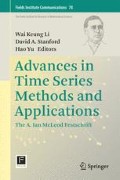Abstract
There is now considerable scientific consensus that the acknowledged increase in global temperatures is due to the increasing levels of atmospheric carbon dioxide arising from the burning of fossil fuels. Large scale global circulation models support this consensus and there have also been statistical studies which relate the trend in temperatures to the carbon dioxide increase. However, causal dependence of one trending series upon another cannot be readily proved using statistical means. In this paper we model the trend corrected series by times series methods which provide a plausible representation of their dependence. A consequence of trend correction and our use of relatively short series is that our model is unable to give precise long-term predictions, but it does illuminate the relationships and interaction between the series.
Access this chapter
Tax calculation will be finalised at checkout
Purchases are for personal use only
References
Akaike, H. (1973). A new look at statistical model identification. IEEE Transactions on Automatic Control, AC–19(2), 716–723.
Dahlhaus, R. (2000). Graphical interaction models for multivariate time series. Metrika, 51, 157–172.
Dahlhaus, R., & Eichler, M. (2003). Causality and graphical models in time series analysis. In P. J. Green, N. L. Hjort, & S. Richardson (Eds.), Highly structured stochastic systems. Oxford: Oxford Universiity Press.
Edwards, D. (2000). Introduction to graphical modelling. New York: Springer.
Hosking, J. R. M. (1980). The multivariate portmanteau statistic. Journal of the American Statistical Association, 75, 602–608.
Hurvich, C. M., & Tsai, C.-L. (1989). Regression and time series model selection in small samples. Biometrika, 76(2), 292–307.
Kuo, C., Lindberg, C., & Thomson, D. J. (1990). Coherence established between atmospheric carbon dioxide and global temperature. Nature, 343, 709–714.
Lauritzen, S. L. (1996). Graphical models. Oxford: Oxford University Press.
Lauritzen, S. L., & Spiegelhalter, D. J. (1988). Local computations with probabilities on graphical structures and their application to expert systems. Journal of the Royal Statistical Society: Series B, 50, 157–224.
Li, W. K., & McLeod, A. I. (1981). Distribution of the residual autocorrelations in multivariate arms time series models. Journal of the Royal Statistical Society: Series B, 43, 231–239.
Lütkepohl, H. (1993). Introduction to multiple time series analysis. New York: Springer.
Reale, M., & Wilson, G. T. (2001). Identification of vector AR models with recursive structural errors using conditional independence graphs. Statistical methods and applications, 10, 49–65.
Reinsel, G. C. (1993). Elements of multivariate time series analysis. New York: Springer.
Schwarz, G. (1978). Estimating the dimension of a model. The Annals of Statistics, 6(2), 461–464.
Sims, C. A. (1996). Are forecasting models usable for policy analysis. Federal Reserve Bank of Minneapolis Quarterly Review, 10, 2–16.
Tunnicliffe Wilson, G., Reale, M., & Haywood, J. (2015). Models for dependent time series. New York: CRC Press.
Whittaker, J. C. (1990). Graphical models in applied multivariate statistics. Chichester: Wiley.
Young, P. C. (2014). Hypothetico-inductive data-based mechanistic modelling, forecasting and control of global temperature. Technical report, Lancaster Environment Center, Lancaster University. http://captaintoolbox.co.uk/Captain_Toolbox.html/Captain_Toolbox.html.
Zellner, A., & Theil, H. (1962). Three-stage least squares: Simultaneous estimation of simultaneous equations. Econometrica, 30, 54–78.
Author information
Authors and Affiliations
Corresponding author
Editor information
Editors and Affiliations
Rights and permissions
Copyright information
© 2016 Springer Science+Business Media New York
About this chapter
Cite this chapter
Tunnicliffe Wilson, G. (2016). Atmospheric \(\hbox {CO}_2\) and Global Temperatures: The Strength and Nature of Their Dependence. In: Li, W., Stanford, D., Yu, H. (eds) Advances in Time Series Methods and Applications . Fields Institute Communications, vol 78. Springer, New York, NY. https://doi.org/10.1007/978-1-4939-6568-7_13
Download citation
DOI: https://doi.org/10.1007/978-1-4939-6568-7_13
Published:
Publisher Name: Springer, New York, NY
Print ISBN: 978-1-4939-6567-0
Online ISBN: 978-1-4939-6568-7
eBook Packages: Mathematics and StatisticsMathematics and Statistics (R0)

